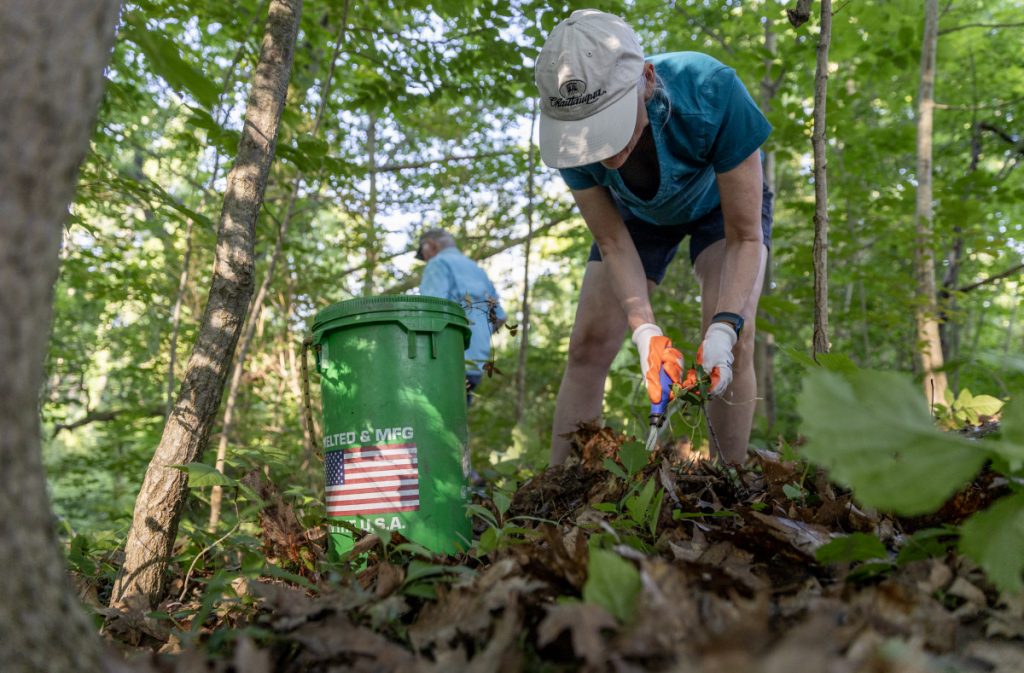
Mariia Novoselia
Staff writer
A few hours of plucking weeds every week can help restore a secret garden of wildflowers.
The Bird, Tree & Garden Club is inviting Chautauquans to join them at 8 a.m. today and every Wednesday by the Butterfly Garden to combat invasive species and help native plants.
Betsy Burgeson, supervisor of gardens and landscapes at Chautauqua Institution, said the goal is to create a nature trail from the Butterfly Garden by South Gate and the Oliver Archives Center, all the way down Massey across the ravine to a “lost” native plant garden.
BTG President Leslie Renjilian said the lost garden has wonderful species but has long been overrun with privet, an invasive plant. The garden can still be reached from the other side of Massey, she said, but BTG’s aspiration is to create a fully accessible path with Chautauquans’ help. Burgeson said the lost garden is also home to stormwater retention projects.
Burgeson said BTG picked the Butterfly Garden to be the starting point of their new project because that area has “such a plethora of every invasive species” found on the grounds of the Institution.
The impact of plucking weeds there, she said, is significant.
“The last thing I want to do is work on a project and not see (the results),” Burgeson said.
Some of the invasive plants, she said, have long resided in private gardens. The vinca, or ivy, for example, has been used as ground cover or in hanging baskets for hundreds of years.

Jean Fulkerson volunteers on Weeding Wednesday last week near the Butterfly Garden. Brett Phelps/Staff Photographer
“People always say ‘I don’t see that this plant is invasive,’ or ‘It’s not invasive in my landscape,’ but that’s because you’re weeding the little guys as they come up,” she said. “When you see the invasives in a forest setting, then you see the true impact of what they can do.”
A “conglomeration of nastiness,” as Burgeson called the invasive plants, leaf out before native plants and wildflowers and block sunlight, preventing the native plants from growing.
She said the project will be “a long labor of love” with the results being well worth the effort.
Invasive species also affect the lake and the greater ecosystem. Hemlocks, for example, are a native plant crucial for keeping Chautauqua Lake cooler, Burgeson said. Because snow stays underneath the hemlocks longer, the stream that leads into the lake stays chilly, too. This, she said, is important for keeping harmful algal blooms down.
“Hemlock forests through this ravine are just absolutely gorgeous,” Burgeson said, but she’s worried that native species such as the hemlock have taken “a real big hit” from the invasives, which are taking the reins in forests and gardens in many ways.
Birds, for example, can spread them by eating their berries and then, well, “going to the bathroom,” Burgeson said. Birds and other animals, however, are not the only agents of invasives.
Many people, Burgeson said, throw the weeds they pull out of their private gardens into the ravine.
“A lot of times it’s fine because they’re not an invasive species … but if you can recognize invasives and put those in your garbage instead of the woods, we’d really appreciate it,” she said, and this is why it is important to educate people about native and invasive plants.
To combat invasives, Burgeson has an array of different tools. Inside the bucket she uses to collect the weeds she pulls, she keeps hooks, spade shovels and other instruments. Burgeson said in the future she may bring a saw to get rid of larger invasives (and also help people “get the aggressions out”).
Jean Fulkerson, BTG volunteer coordinator, created a flipbook to help distinguish between native plants and invasives. She said she consulted Burgeson on what plants to include and used her own gardening experience.
Invasive species can often look incredibly similar to native ones, Burgeson said. That’s why BTG adds pink tape to some while working – it signifies that the plant is good for the ecosystem.
“If in doubt, as I tell my crew, don’t pull it out,” Burgeson said. Instead, she recommended double-checking if a plant is invasive by asking BTG members or someone with weeding experience.
She said volunteers are welcome to bring their own gloves, although BTG has some back-up ones. The only thing people need to participate in Weeding Wednesdays is “the ability to pinch the weeds and pull them up.” Pre- and post-contact poison ivy wipes, along with insect spray, will also be provided.
Burgeson said the effects of last summer’s weeding has made a noticeable difference.
“For the first time, … there were flowers I hadn’t seen there before because they were just so crowded out. It’s really exciting (and) encouraging,” Burgeson said.
She encouraged parents to bring children to Weeding Wednesdays to help emphasize the importance of a collective effort.
“I’m excited to get started on the project, … because what we were able to do on the other side of the trail was just incredible,” Burgeson said.




